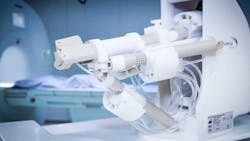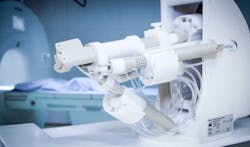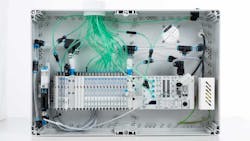Robotic Probe Makes Prostate Biopsies More Accurate
Prostate cancer is one of the most common cancers and the second leading cause of cancer-related death in men in the U.S. The American Cancer Society estimates there were 192,000 new cases last year and about 33,000 of them will die from it. The group also predicts that about 1 in 9 men will be diagnosed with prostate cancer sometime in their life. The key to surviving the diagnosis is to get it early in the disease’s progression. Early treatment is usually the most effective, with the fewest side-effects and the lowest cost.
Currently, surgeons rely on ultrasound to image the prostate when taking biopsies, but it lacks the resolution to reveal tumor sites. Only MRI can detect and target the most aggressive part of the lesions on the prostate. So, urologists make randomized systematic biopsies using ultrasound which consists of 12 to 16 samples taken from different portions of the prostate. This means the new robotic procedure is quicker and less problematic for patients. Less time also means lower costs and more efficient and effective use of the MRI machine.
To make diagnosing prostate cancer more accurate and easier on the patient, a team of engineers at Soteria Medical BV, a Dutch company, went to work designing a Remote-Controlled Manipulator (RCM) that contains five motors. The team wanted a surgeon-controlled robot that would precisely position the biopsy probe to sample suspicious areas of the prostate. The procedure takes place inside an MRI machine, so the surgeon can see real-time imaging of the prostrate and probe, which helps when guiding the probe to its target.
But this meant the robot could not contain metal, as that would interfere with the MRI. The robot would also have to be compact enough to fit inside the MRI machine along with the patient.
To keep the RCM metal-free, the design team partnered with Festo on pneumatic power to move and position the probe using plastic pneumatic stepper motors controlled by a Festo valve terminal type MPA. The entire RCM is made of MRI-compatible, high-quality plastics. The robotic probe is connected by more than 20 feet of pneumatic tubing to a control unit. This lets the controller be placed in the MRI control room.
For this application, the high-speed MPA valves use a CPX control interface, and the entire unit comes pre-assembled and pre-tested in a ready-to-install control box. It can hold enough valves to control the five different motors in the robot. The CPX interface on the valve uses serial communication for all the solenoid coils and electrical input and output functions. This single network handles end-to-end internal diagnostics and reduces internal connections, ensuring a reliable product.
The compact CPX/MPA combination saves valuable space, while the ready-to-install package saves time and reduces inventory. The valves give the robot a high cycle life, repeatable speeds and well-documented reliability.
Partial automation by the RCM makes the biopsy less stressful for the patient. Plus, the robot’s precision and the MRI imaging lets the machine take one or two samples from any suspicious area.
This article appeared in Hydraulics & Pneumatics.


